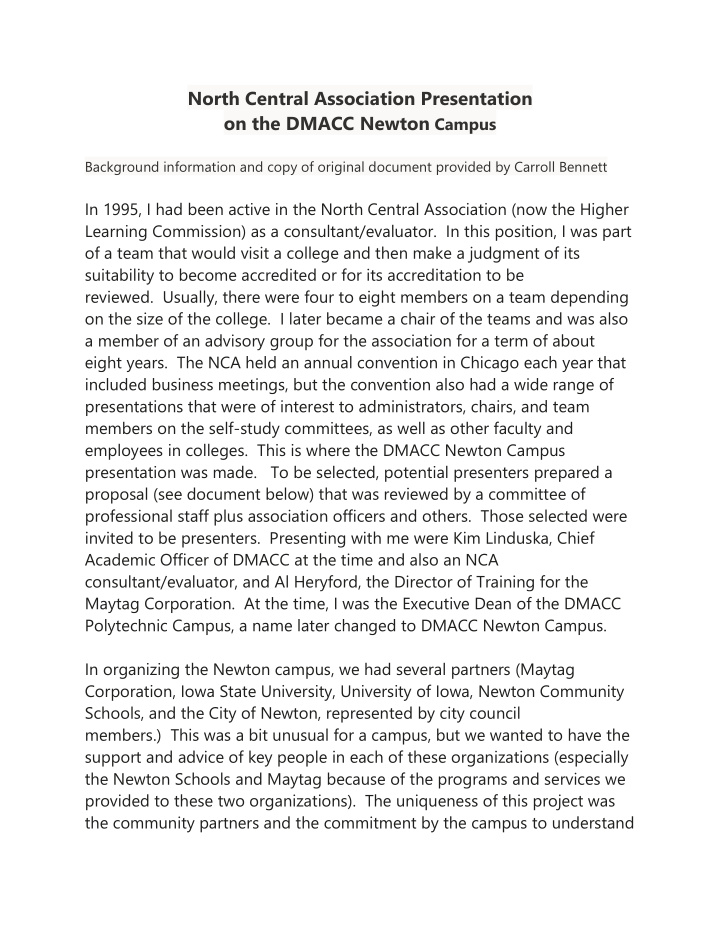



North Central Association Presentation on the DMACC Newton Campus Background information and copy of original document provided by Carroll Bennett In 1995, I had been active in the North Central Association (now the Higher Learning Commission) as a consultant/evaluator. In this position, I was part of a team that would visit a college and then make a judgment of its suitability to become accredited or for its accreditation to be reviewed. Usually, there were four to eight members on a team depending on the size of the college. I later became a chair of the teams and was also a member of an advisory group for the association for a term of about eight years. The NCA held an annual convention in Chicago each year that included business meetings, but the convention also had a wide range of presentations that were of interest to administrators, chairs, and team members on the self-study committees, as well as other faculty and employees in colleges. This is where the DMACC Newton Campus presentation was made. To be selected, potential presenters prepared a proposal (see document below) that was reviewed by a committee of professional staff plus association officers and others. Those selected were invited to be presenters. Presenting with me were Kim Linduska, Chief Academic Officer of DMACC at the time and also an NCA consultant/evaluator, and Al Heryford, the Director of Training for the Maytag Corporation. At the time, I was the Executive Dean of the DMACC Polytechnic Campus, a name later changed to DMACC Newton Campus. In organizing the Newton campus, we had several partners (Maytag Corporation, Iowa State University, University of Iowa, Newton Community Schools, and the City of Newton, represented by city council members.) This was a bit unusual for a campus, but we wanted to have the support and advice of key people in each of these organizations (especially the Newton Schools and Maytag because of the programs and services we provided to these two organizations). The uniqueness of this project was the community partners and the commitment by the campus to understand
and address the educational needs of business, industry, and associations in addition to traditional two-year college students. It made the entire DMACC organization available and easily accessible to our local constituents. The session was well attended, and we even had a follow up inquiry from a college in London, England, about assisting them in setting up a similar program. We thanked them, but told them they were beyond "our service area." It was fun to put this campus together because everyone in Newton wanted it to happen and went out of their way to help us get the college established and operating only 11 months after the project was announced. To get around all the red tape involved with getting approval for a new campus from the Iowa Department of Education, the facility was owned by the DMACC Foundation (the state had no authority over this independent body). We had an agreement with Maytag that the ownership of the building would revert to DMACC after 15 years, which it did. It was also helpful to have been a long-time friend of the CEO of Maytag, Leonard Hadley and to have my younger brother, Jim Bennett, Vice Counsel of Maytag, in charge of the legal work team that wrote the contracts with DMACC. The Newton campus was a project that everyone in the community supported because they saw the potential for the students, workers in the community, and others to enhance their education at low cost in an accessible facility. Copy of original proposal below:
https://files.eric.ed.gov/fulltext/ED387199.pdf
Recommend
More recommend